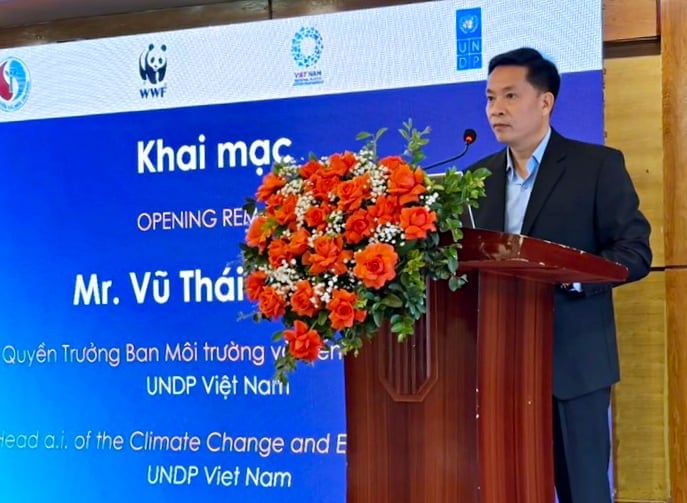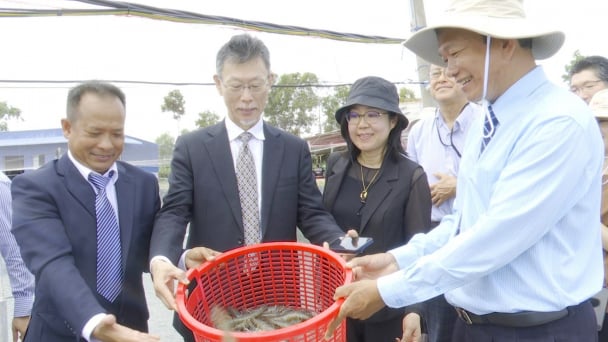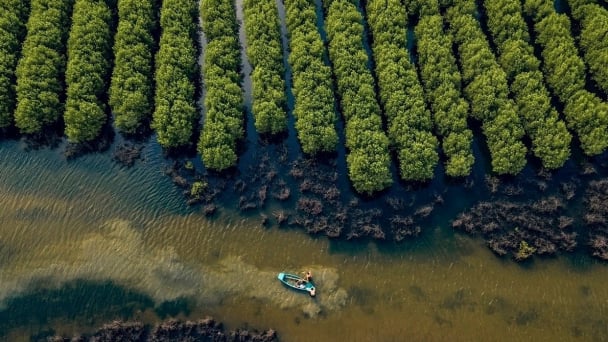June 14, 2025 | 21:14 GMT +7
June 14, 2025 | 21:14 GMT +7
Hotline: 0913.378.918
June 14, 2025 | 21:14 GMT +7
Hotline: 0913.378.918
Since the end of 2024, farmers - primarily ethnic minority communities in five provinces of the Central Highlands and South Central Coast, have begun accessing agricultural climate bulletins tailored to local farming practices. This marks an initial outcome of the SACCR Project, funded by the Green Climate Fund and technically supported by UNDP. The project is being implemented in 68 communes across 15 districts of Dak Lak, Dak Nong, Khanh Hoa, Ninh Thuan, and Binh Thuan provinces, with the goal of enhancing the resilience of small-scale agriculture to the impacts of climate change and water scarcity.
What specific activities has the SACCR Project implemented to help farmers address challenges from extreme weather events, Mr. Truong?
In reality, local agricultural sectors already provide production advisory bulletins. However, the literacy rate and access to the internet or smartphones remain low among ethnic minority communities. These farmers often rely on traditional knowledge or word of mouth, which can lead to inaccurate and inefficient farming decisions. This presents a significant challenge in accessing and applying climate information to agricultural production and in shifting farming practices.
In this context, the project has supported the construction of rainwater storage ponds in farming areas and last-mile connection systems, combined with training on water resource management. At the same time, we have developed seasonal and crop-specific agricultural climate advisory bulletins, based on both short- and long-term forecasts and integrated with local agricultural information.
The content of the bulletins focuses on key factors for agricultural production, such as crop calendars, detailed weather forecasts, and technical recommendations on cultivation and pest control tailored to the region’s main crops (e.g., coffee, durian, and pepper in the Central Highlands; maize, onions, and cassava in Ninh Thuan).
To date, more than 20,000 households have accessed these bulletins through a variety of channels, including loudspeakers, SMS messages, the Zalo app, community meetings, and agricultural training sessions.
In addition, the project also focuses on enhancing the capacity of agricultural extension officers, technical collaborators, and key farmer representatives to use climate information effectively. We have organized over 400 Farmer Field Schools (FFS) with the participation of 24,000 farmers, helping them better understand meteorological information and proactively apply it in their farming practices.
In selected pilot areas, the SACCR Project has implemented climate-adaptive agricultural models, integrating climate advisory services with the trial of new crop varieties, sustainable farming techniques, and efficient irrigation practices.
Encouragingly, these models have achieved a success rate of over 85%, leading to productivity increases of 10–15%. During the early phase of the project, farmers also received support in the form of input and fertilizer vouchers based on performance outcomes.
The climate bulletin can be considered the most crucial component. How do you ensure that local people trust the bulletin and follow the project’s production recommendations?
UNDP plays a key role in coordinating with the Central Project Office for Irrigation Projects, the Ministry of Agriculture and Environment, and the five participating provinces. We support the establishment and capacity building of Agricultural Climate Information Services (ACIS) Technical Advisory Groups at both provincial and district levels.
These groups typically consist of representatives from meteorological and hydrological agencies, the agricultural sector, local technical departments, as well as farmer representatives, farmer groups, and agricultural cooperatives. This multi-stakeholder structure ensures close coordination in developing climate bulletins that are tailored to local needs and agricultural practices, and in effectively disseminating them to farming communities.

SACCR strengthens the capacity of agricultural extension officers on climate-resilient agriculture in Binh Thuan. Photo: DL.
An important aspect of the project is empowering local authorities to take the initiative in deciding the content of the bulletins. This approach ensures flexibility and suitability to the specific context of each area in the communication methods used to reach the community. The close coordination between the technical advisory groups and the grassroots agricultural extension system also helps disseminate information widely to farmers and supports their production activities.
Additionally, the project encourages the integration of the ACIS advisory groups into local climate change programs and agricultural development plans, creating mechanisms to sustain these activities over the long term.
Sir, what has the project done to shorten the gap between communication and action, especially in preparing for extreme weather events?
This is indeed a major challenge: how to transform forecast information which is probabilistic and rapidly changing, into specific, easy-to-understand, and timely recommendations for people facing hazardous weather conditions.
Within the framework of the SACCR Project, we have implemented several key solutions. The establishment and strengthening of ACIS technical groups at both provincial and district levels serve as an early warning network. Members from meteorological agencies within the groups are responsible for closely monitoring extreme weather developments and promptly notifying all ACIS members to quickly relay information to the community.
To reduce communication time, the project has piloted the use of diverse communication channels, including upgrading and repairing local loudspeaker systems, community Zalo groups, bulletin boards in communes, and village collaborator networks.
The project also focuses on raising community awareness about agricultural climate information. Through training sessions, people are educated on the reliability of forecasts, how to interpret symbols in the bulletins, and most importantly, how to take appropriate action based on different risk levels.

Mr. Vu Thai Truong, Acting Head of Climate Change and Environment at UNDP Vietnam. Photo: DL.
How have people changed after receiving support from the project, sir?
The seasonal agricultural climate advisory bulletin system has been developed and implemented in 15 districts, including many remote communes and ethnic minority areas. The bulletins are designed to be easy to understand and suited to local farming conditions, as well as the literacy levels of the people. We also maintain regular interactions with local officials to capture actual needs and feedback from the community. Statistics show that over 20,000 farming households within the project area regularly access timely forecast bulletins.
The integration of climate risk advisory with other project components, such as supporting climate-resilient agricultural models, rehabilitating small irrigation infrastructure, and enhancing risk management capacity, has created a clear synergistic effect. People not only receive information but also have the means to apply it in practice, thereby increasing their proactiveness and resilience to climate change.
The project has also contributed to strengthening people’s trust in forecast information, as well as reinforcing the role of the agricultural extension system and local technical advisory groups.
Although a final quantitative evaluation has not yet been conducted, based on ongoing activities, we expect about 60% of households will change their agricultural practices after accessing and using the agricultural climate bulletins. In terms of economic efficiency, we anticipate crop yields to increase by over 10% and farmers’ incomes to rise by 15–18%. More importantly, both officials and farmers have improved their knowledge and skills to proactively utilize forecast information in production planning.
Thank you very much, sir!
Translated by Phuong Linh

(VAN) In Tien Giang, a high-tech shrimp farm has developed a distinctive energy-saving farming model that has yielded promising results.
![Turning wind and rain into action: [3] 300.000 farmers benefit from agro-climatic bulletins](https://t.ex-cdn.com/nongnghiepmoitruong.vn/608w/files/news/2025/06/12/e5a48259d6a262fc3bb3-nongnghiep-125122.jpg)
(VAN) The agro-climatic bulletin has become a valuable tool for farmers in the Mekong Delta. After more than five years of implementation, the initiative is gradually being expanded nationwide.
![Turning wind and rain into action: [2] Providing forecasts to the people](https://t.ex-cdn.com/nongnghiepmoitruong.vn/608w/files/news/2025/06/12/e5a48259d6a262fc3bb3-nongnghiep-103927.jpg)
(VAN) In addition to improving the quality of hydrometeorological forecasts, putting forecast bulletins into practical use is crucial for production and disaster prevention.

(VAN) Blue carbon is receiving attention for its rapid absorption capacity and vast potential. It represents a promising nature-based solution to respond to climate change.
/2025/06/11/3507-1-161904_583.jpg)
(VAN) Seagrass beds and coral reefs serve as 'cradles' that nurture life in the ocean depths, creating rich aquatic resources in Vietnamese waters.
![Turning wind and rain into action: [1] Forecasting for farmers](https://t.ex-cdn.com/nongnghiepmoitruong.vn/608w/files/news/2025/06/11/e5a48259d6a262fc3bb3-nongnghiep-111919.jpg)
(VAN) Weather is no longer just a matter of fate. Forecasts have now become an essential companion for farmers in every crop season.